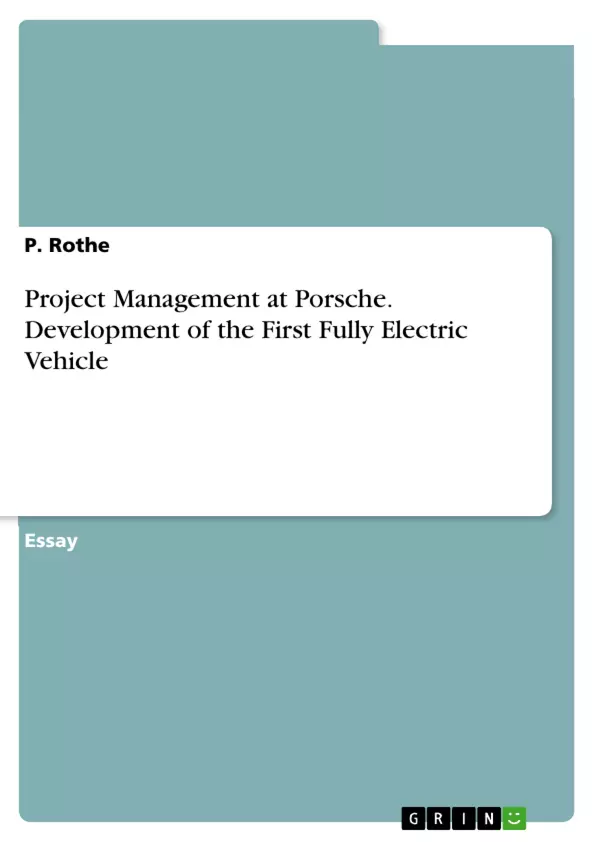This essay uses the development of the first fully electric vehicle as an example to analyze Porsche's project management.
After starting the project to develop a fully electric vehicle in 2015, Porsche performed research and built different concept cars for three years. After another year of further optimization on the final car, they finished the project after four years by delivering the first fully electric car at the end of 2019. The name of the car is Porsche Taycan. While Porsche knew the scope of developing a car and already had contact to most stakeholders, this project still was different from their other operations.
Inhaltsverzeichnis (Table of Contents)
- Executive Summary
- Description of the project: Porsches launches its first electric vehicle
- Porsches Vision, Mission and Values and the connection to the project
- Connecting vision, mission and values to the project
- Rationale behind the project
- Conclusion
Zielsetzung und Themenschwerpunkte (Objectives and Key Themes)
This document explores the development and launch of Porsche’s first fully electric vehicle, the Taycan. The report aims to analyze the project’s success in light of Porsche’s core values, focusing on how the project aligns with the company’s vision, mission, and values. It also examines the project's financial feasibility, including its net present value (NPV).
- Porsche’s Vision, Mission, and Values and their relevance to the Taycan project
- The challenges and opportunities of launching a fully electric vehicle for a brand known for its gasoline engines
- The financial feasibility of the project, including its NPV and payback period
- The project’s success in terms of its alignment with Porsche’s core values and its contribution to the company’s future
- The impact of the project on Porsche's brand image and its contribution to the development of electric vehicles in the automotive industry.
Zusammenfassung der Kapitel (Chapter Summaries)
The first chapter introduces Porsche, its history, and its commitment to developing high-performance sports cars. It outlines the company’s decision to launch its first fully electric vehicle, the Porsche Taycan, highlighting the significance of this move for a brand traditionally associated with powerful gasoline engines. The project's origins are traced back to the “Frankfurt International Motor Show” in 2015, where Porsche first announced its development of an electric vehicle.
The second chapter delves into Porsche’s vision, mission, and values. It explores how these core principles guided the development of the Taycan, showcasing the company’s commitment to innovation, sustainability, and performance. The chapter emphasizes how building an electric vehicle aligns with Porsche’s values, particularly its focus on driving change for a sustainable world. The chapter concludes with a discussion of Porsche’s slogan “Shaping the future of the sportscar,” which reinforces its commitment to innovation and its role in the evolving automotive industry.
The third chapter focuses on the rationale behind the project, analyzing the financial feasibility of the Taycan’s development and launch. Despite the lack of publicly available figures on the exact costs, the chapter presents a rough NPV calculation using the available information. It considers the financial investments made by Porsche, the estimated sales revenue, and the discount rate for the automotive sector. The chapter concludes that the project has a positive NPV, indicating a favorable return on investment.
Schlüsselwörter (Keywords)
The key concepts and terms in this document include: Porsche, electric vehicle, Taycan, sustainability, vision, mission, values, innovation, performance, NPV, financial feasibility, brand image, automotive industry. It explores the intersection of Porsche’s values with its strategic decision to develop and launch a fully electric vehicle, analyzing the financial and environmental implications of this shift.
- Arbeit zitieren
- P. Rothe (Autor:in), 2022, Project Management at Porsche. Development of the First Fully Electric Vehicle, München, GRIN Verlag, https://www.grin.com/document/1357316



